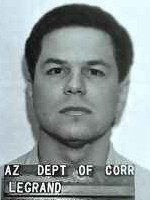- Home
- State Information
- Resources
- CCRI Materials
- Mental Health Fact Sheets
- Autism Spectrum Disorder
- Borderline Intellectual Functioning
- Bipolar Disorder
- Complex Trauma
- Epilepsy
- Executive Function Impairment
- Fetal Alcohol Syndrome Disorders
- Intellectual Disability
- Major Depressive Disorder
- Posttraumatic Stress Disorder
- Schizophrenia
- Specific Learning Disorder
- Substance-Related and Addictive Disorders
- State Information
- Mental Health Fact Sheets
- Browse
- Search
- CCRI Materials
- News & Developments
- Search
- About Us
- Log In
- Register
Arizona
 The information on this page provides a brief overview of capital clemency in Arizona and is not intended to serve as the basis for a capital clemency petition or campaign. For additional information and sources, please see the full Arizona Clemency Memo (November 2016) prepared by the ABA Capital Clemency Resource Initiative.
The information on this page provides a brief overview of capital clemency in Arizona and is not intended to serve as the basis for a capital clemency petition or campaign. For additional information and sources, please see the full Arizona Clemency Memo (November 2016) prepared by the ABA Capital Clemency Resource Initiative.
Contents
Arizona Capital Clemency Memo
The Power Defined
Under Article 5, Section 5 of the Arizona Constitution, the clemency power rests with the governor “to grant reprieves, commutation, and pardons, after convictions, for all offenses except treason and cases of impeachment, upon such conditions and with such restrictions and limitations as may be provided by law.”
The Decision Maker(s)
In Arizona, the governor has ultimate authority to grant clemency in capital cases. The law, however, provides “restrictions and limitations” on the governor’s clemency authority through the creation of the Board of Executive Clemency (“Board”). The Board “shall have exclusive power to pass upon and recommend reprieves, commutations, paroles and pardons. No reprieve, commutation or pardon may be granted by the governor unless it has first been recommended by the Board.” (Ariz. Rev. Stat. Ann. § 31-402(A)). Any applications made directly to the governor are forwarded to the Board for its recommendation.
The Board consists of five members appointed by the governor and confirmed by the Arizona Senate. Appointments must be made “on the basis of broad professional or educational experience;” appointees “shall have demonstrated an interest in the state’s correctional program;” and there cannot be “more than two members from the same professional discipline” on the Board at one time. (Ariz. Rev. Stat. Ann. § 31-401(A); 38-211(A)-(C)). Board appointees serve terms of five years and may be “removed by [the] Governor for cause.” (Ariz. Rev. Stat. Ann. 31-401(D)-(E)). The board may choose where and when to convene, but “shall meet at least once a month at the state prison…” (Ariz. Rev. Stat. Ann. 31-401(H)).
Board members must undergo training. Appointees must complete a four-week course “relating to the activities of the Board,” “designed and administered by the chairman of the Board,” and “conducted by the Office of the Board of Executive Clemency and the Office of the Attorney General.” (Ariz. Rev. Stat. Ann. § 31-401(C)). The only specified content of the course is “training in all statutes that pertain to the Board and participation in a decision making workshop.” (Ariz. Rev. Stat. Ann. 31-401(C)). There are no other published requirements for materials that must be reviewed or how such training curricula must be developed. However, if the training requirements that are in place are not met, a temporary stay of execution may be granted until the appropriate training can take place.
How Petitions are Brought
The Board of Executive Clemency processes all clemency requests, and all Board policies can be found online.
Pardon Applications
Applications for a pardon must include an application form (original and an additional copy, both notarized), fingerprints, pre-sentence reports and court sentencing documents, documentation of payment of court fees and any ordered restitution, certain court orders that may have been obtained, and a minimum of three letters of support (only one of which may be from a family member). If applying while imprisoned, applications must also include an affidavit of publication of the application in the county of conviction and green card return receipts from the certified mailing to the prosecutor in county of conviction. It is recommended that applications include a current resume, proof that child support is paid or the order has been satisfied (if applicable), and any other documentation the applicant wishes the Board to consider. If denied a pardon, either because the Board did not make a recommendation to the governor or because the governor rejected the recommendation, the applicant must wait three years to apply again. The exception to the three-year reapplication period is if a warrant of execution is issued during that time frame.
Commutation Applications
Commutation applications have different timing and submission requirements than pardon applications. Unless the Board Chairman approves otherwise, an application for commutation of sentence may not be made until a petitioner has served two years of a sentence with more than one year remaining. According to Board Policy, exceptions occur when a judge issues a special “§ 13-603(L) order,” allowing the prisoner to bring a commutation application because he or she feels a required sentence is “clearly excessive”, a petitioner is “under imminent danger of death” (within three months as certified by the Department of Corrections (“ DOC”)), or a petitioner has received a warrant of execution from the Supreme Court of Arizona. A judge’s § 13-603(L) order for the Board’s review must state the reason(s) why a sentence seems excessive. Imminent danger of death means that, “an applicant has been examined by a medical doctor and that doctor has diagnosed the applicant as suffering from a medical condition which, in the doctor’s professional medical opinion, will to a reasonable medical certainty result in the applicant’s death within four (4) months.” Applications for commutation are submitted to the DOC to review for eligibility, in which case the DOC forwards it to the Board.
Only the completed application form, which includes questions regarding the petitioner’s complete personal, family, and criminal history, needs to be submitted. Though Arizona law specifies that, following a denial of commutation, a petitioner may not reapply for clemency for at least five years, Board policy puts that reapplication period at only three years. The same three exceptions noted above apply to the reapplication period and the initial application. Furthermore, if the Board unanimously recommends commutation and the governor does not act within ninety days after receiving the recommendation, the recommendation automatically becomes effective. Research has not revealed this ever having occurred in a death penalty case.
Hearing Practice
When the Board receives notice that an execution warrant has been issued, the chairman will be notified and “[t]he Executive Director shall contact the inmate’s attorney to determine if the [prisoner] wishes to” proceed with a hearing. According to Board policy, the hearing can encompass consideration of a pardon, commutation or reprieve, depending on what relief the petitioner seeks. However, “the Board should not make a pardon consideration an automatic part of Clemency hearing if the inmate does not request it.” Hearings must take place between one day after the execution date is set, and seven days prior to the execution. All Board hearings are required to be public. Hearings are conducted in an informal manner and are not bound by rules of evidence that would be applied in a judicial proceeding.
The full procedure for a clemency hearing when the petitioner is under warrant of execution is laid out in Board policy. Written notification is sent to the Governor, the Supreme Court of Arizona, director of the DOC, state and defense attorneys, warden of the prison where the hearing is scheduled, known victim(s), petitioner, and any other interested persons; it is also publicized on the Board’s website and location. Board policy requires that all clemency hearings in capital cases must be recorded.
At a clemency hearing, the petitioner is considered for a pardon (if applicable), commutation, and reprieve. The hearing is conducted according to the same guidelines as for parole, but the hearing must conclude on the same day, and the chairman of the Board may set time limits for presentations (which must be declared at the start of the hearing).
For a pardon hearing, the applicant must receive “advance written notice” of the date and location. Written notice is given at least ten days before the hearing to the county attorney of the county of conviction, and must also be published for thirty days in a paper in that county.
For a commutation hearing, the victim, county attorney, and presiding judge are to be given notice and an opportunity to be heard. Board policy adds the Arizona Attorney General to the list of those to be notified and specifies that the victim should get fifteen days’ notice prior to the hearing date.
In practice, capital clemency hearings for death row prisoners are typically not scheduled until a warrant of execution has been handed down and the execution date has been set. The hearing is automatically scheduled whether or not it is requested, and it takes place two to three days prior to the scheduled execution. Though a formal application is not required, the death row prisoner and his or her supporters may submit letters for consideration to the Board prior to the hearing. The hearing is a reprieve hearing to determine if the execution should move forward. If the Board decides to recommend a reprieve to the governor, it may also recommend commutation of sentence or a pardon at that time.
Responding to a Petition
The governor and the Board have different reporting requirements for clemency decisions. If the governor grants a commutation, pardon, or reprieve of a capital sentence, he or she must publish the reasons for the grant in a newspaper in the county of conviction and in the Arizona administrative register. However, the governor is not required to give reasons for the denial of clemency in either a capital or a non-capital case. Board members may provide the governor with their reasons for voting for or against a clemency application, but are not required to do so. Arizona’s courts have explained there is no “constitutionally protectible [sic] interest such that parole boards are required to state their reasons for denying commutation.” Arnold v. Ariz. Bd. of Pardons & Paroles, 805 P.2d 388, 391 (Ariz. Ct. App. 1990). The court stressed that “the legislature [in A.R.S. § 31-402(A)] has enumerated no criteria the board must apply in determining whether to recommend commutation,” and therefore petitioners have no basis on which to expect clemency will be granted.
Current Clemency Decision Maker(s)
The Board: Current board members include Mina Mendez (Chair, term expires 2022), Frank D. Riggs (term expires 2024), Louis Quinonez (term expires 2026), Sal Freni (term expires 2022), and Michael Johnson (term expires 2025). Complete biographies can be found online.
The Governor

Republican Governor Douglas “Doug” Ducey is serving his second term as governor of Arizona; he was sworn in on January 5, 2015 and reelected in 2018.
Governor Ducey supports the death penalty. In 2015, when Attorney General Eric Holder called for states to halt all executions pending the U.S. Supreme Court’s review of Oklahoma’s lethal injection protocols, Governor Ducey refused to comply. A spokesperson for Governor Ducey released a statement on the matter, saying, “Governor Ducey has no plans to do this – he will be following the law. His concern will always be for victims of crime first.”
Governor Ducey has expressed some interest in reexamining death penalty processes. Regarding a botched execution in 2014, he stated “but we can certainly do better … than taking two hours.” “I would want to consult with medical experts for how to do that.” In the same article, however, he reiterated his support for the death penalty.
In May of 2021, Arizona announced that it was refurbishing its gas chamber and planned to resume executions using hydrogen cyanide, a lethal gas weaponized by the Nazis during the Holocaust. The gas chamber, located at Arizona State Prison Complex-Florence, has not been used since the execution of Walter LaGrand in 1999. It took Mr. LaGrand 18 minutes to die via lethal gas. In April of 2021, Arizona’s Attorney General, Mark Brnovich, filed notices of intent to seek warrants of execution with the Arizona Supreme Court for two individuals on Arizona’s death row, Clarence Dixon and Frank Atwood. Arizona’s most recent execution occurred in 2014, when Joseph R. Wood was put to death with lethal drugs.
Significant Past Capital Clemency Decisions
Grants
There have been no grants of capital clemency in Arizona. The Board has never issued a recommendation to pardon or commute the sentence of a death row petitioner. Individual board members have voted for clemency in some cases, but a majority of members have never recommended clemency.
Denials (where newsworthy or controversial)

source: Ariz. Dept. of Corrections
Jeffrey Landrigan’s case garnered national attention in 2010 when his sentencing judge, Judge Cheryl Hendrix, publicly stated, “Had the trial counsel presented any of the mitigating information I have received [since the sentencing trial] – which was available at the time of sentencing – Mr. Landrigan would not have been sentenced to death.” Landrigan’s attorneys petitioned the Arizona Board of Executive Clemency for clemency, citing his trial counsel’s failure to present mitigating evidence and conflicting DNA evidence. A four-member board considered a motion for a commutation and voted 2-2 to recommend clemency. However, by statute, a tie vote operates as a denial. Landrigan was executed on October 26, 2010.

Walter LaGrand’s case made international headlines in 1999. The German-born LaGrand brothers were convicted for fatally stabbing a bank manager during a botched robbery. The German government appealed to Arizona’s then-Governor Jane Hull (1997–2003), a Republican, on behalf of the brothers, who had never been naturalized as Americans and were therefore entitled to consular assistance under the Vienna Convention on Consular Relations. Governor Hull did not follow the Board’s recommendation of a 60-day reprieve and allowed Walter LaGrand’s execution to proceed.
In February 2012, the Board voted 4-1 against recommending that Governor Jan Brewer reduce Robert Henry Moormann’s death sentence to life in prison for the murder and dismemberment of his 74-year old adoptive mother, Roberta. Several psychologists diagnosed Moormann as mentally impaired, and evidence showed that he had a history of being sexual abused by the victim. His attorneys argued that because of his mental impairment, it was unconstitutional to execute him. The prosecutor argued that Moorman did not meet Arizona’s standard for sufficient intellectual disability to be exempt from execution and argued that evidence suggesting he planned the murder showed he had the requisite mental capacity to be executed.
Arizona Resources
Click here to view Arizona resources for download, including clemency petitions and other relevant practice materials. Please note that not all of the content will be visible to users who are not currently logged in or do not otherwise have practitioner-access to the website.
Page last updated on August 26, 2021
